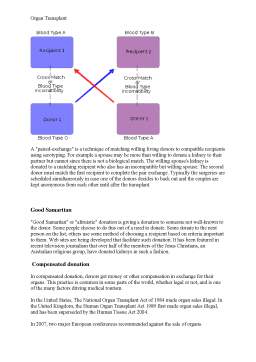Extras din curs
An Organ transplant is the moving of an organ from one body to another or from a donor site on the patient's own body, for the purpose of replacing the recipient's damaged or absent organ. The emerging field of Regenerative medicine may soon allow organs to be re-grown from the patient's own cells (stem cells, or cells extracted from the failing organs.)
Organs that can be transplanted are the heart, kidneys, liver, lungs, pancreas, intestine, and skin. Tissues include bones, tendons, cornea, heart valves, veins, and arms. Worldwide, the kidneys are the most commonly transplanted organs.
Transplantation medicine is one of the most challenging and complex areas of modern medicine. Some of the key areas for medical management are the problems of transplant rejection, during which the body has an immune response to the transplanted organ, possibly leading to transplant failure and the need to immediately remove the organ from the recipient. When possible, transplant rejection can be reduced through serotyping to determine the most appropriate donor-recipient match and through the use of immunosuppressant drugs.
In most countries there is a shortage of suitable organs for transplantation. Countries often have formal systems in place to manage the process of determining who is an organ donor and in what order organ recipients receive available organs.
Transplantation also raises a number of bioethical issues, including the definition of death, when and how consent should be given for an organ to be transplanted and payment for organs for transplantation.
United States
Acceptable organ donors can range in age from newborn to 80 years plus. People who are 80 years of age or older may be acceptable donors, particularly of corneas, skin, bone, or for total body donation. An estimated 10,000 to 14,000 people who die each year meet the criteria for an organ donation, but less than half of that number becomes actual organ donors. Donor organs are matched to waiting recipients through a national registry, called the Organ Procurement and Transplantation Network (OPTN). This registry is operated by an organization known as the United Network for Organ Sharing (UNOS), which is located in Richmond, Virginia. Currently there are 58 organ procurement organizations (OPOs) across the country, which provide organ procurement services to some 261 transplant centers. All hospitals are required by law to have a "Required Referral" system in place. Under this system, the hospital must notify the local Organ Procurement Organization (OPO) of all patient deaths. If the OPO determines that organ and/or tissue donation is appropriate in a particular case, they will have a representative contact the deceased patient's family to offer them the option of donating their loved one's organs and tissues. By signing a Uniform Donor Card, an individual indicates his or her wish to be a donor. However, at the time of death, the person's next-of-kin will still be asked to sign a consent form for donation. It is estimated that about 35 percent of potential donors never become donors because family members refuse to give consent.
Types of transplants
Autograft
Transplant of tissue to the same person. Sometimes this is done with surplus tissue, or tissue that can regenerate, or tissues more desperately needed elsewhere (examples include skin grafts, vein extraction for CABG, etc.) Sometimes an autograft is done to remove the tissue and then treat it or the person, before returning it (examples include stem cell autograft and storing blood in advance of surgery).
Allograft
An allograft is a transplant of an organ or tissue between two genetically non-identical members of the same species. Most human tissue and organ transplants are allografts. Due to the genetic difference between the organ and the recipient, the recipient's immune system will identify the organ as foreign and attempt to destroy it, causing transplant rejection. To prevent this, the organ recipient must take immunosuppressant. This dramatically affects the entire immune system, making the body vulnerable to pathogens.
Isograft
A subset of allografts in which organs or tissues are transplanted from a donor to a genetically identical recipient (such as an identical twin). Isografts are differentiated from other types of transplants because while they are anatomically identical to allografts, they don't trigger an immune response.
Xenograft and xenotransplantation
A transplant of organs or tissue from one species to another. An example are porcine heart valve transplants, which are quite common and successful. Another example is attempted piscine-primate (fish to non-human primate) transplant of islet (i.e. pancreatic or insular tissue) tissue. The latter research study was intended to pave the way for potential human use, if successful. However, xenotransplantion is often an extremely dangerous type of transplant because of the increased risk of non-compatibility, rejection, and disease carried in the tissue.
Split transplants
Sometimes a deceased-donor organ, usually a liver, may be divided between two recipients, especially an adult and a child. This is not usually a preferred option because the transplantation of a whole organ is more successful.
Preview document
Conținut arhivă zip
- Organ Transplant.doc























